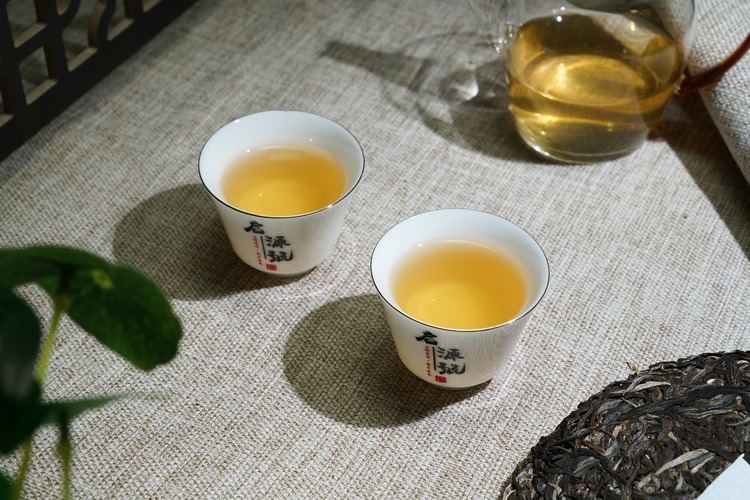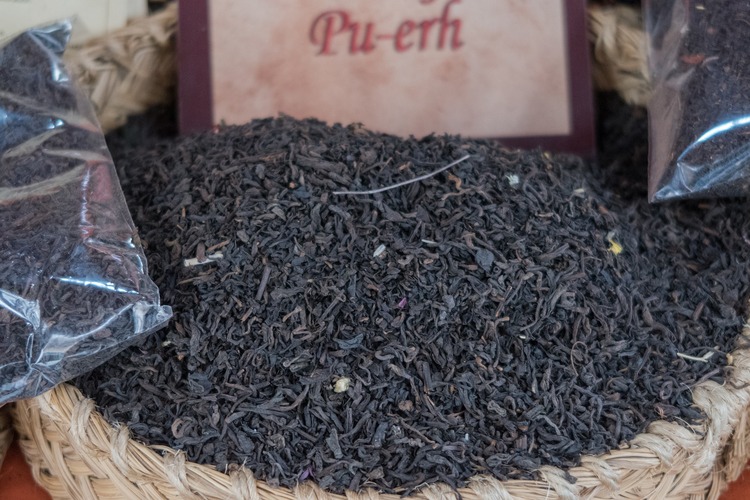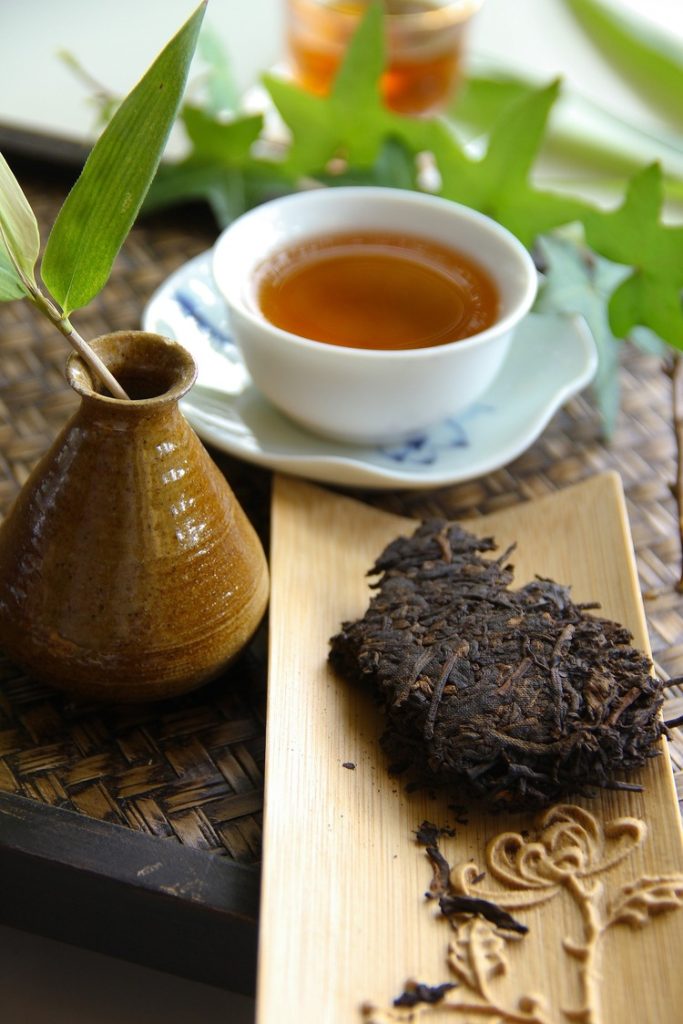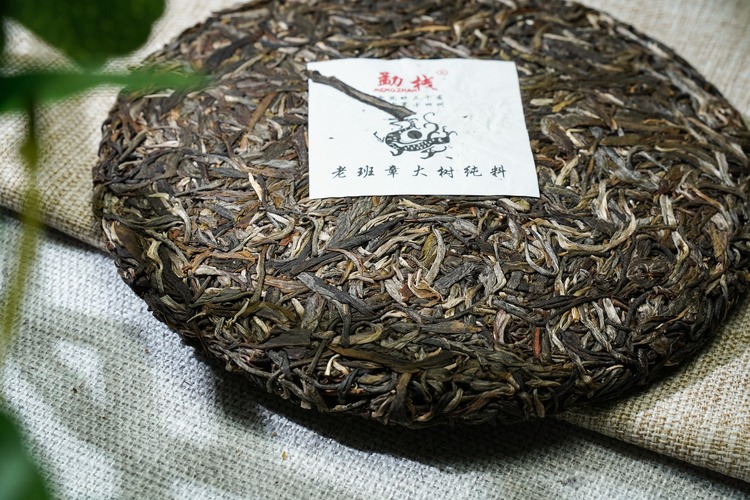What does Pu erh tea taste like? Pu erh is a fermented tea that originates from China’s Yunnan province.
Pu erh tea has a flavor that sets it apart from other types of tea. Some describe its taste as earthy, woody, or musty, with a slightly bitter aftertaste. Detecting leather, tobacco, and mushroom notes in this tea is also common. The flavor of Pu erh tea can vary depending on the age and processing method of the tea leaves, as well as the brewing time and temperature.
This is a one-of-a-kind tea, and I encourage you to keep reading to learn more about it.
Please note: This article contains affiliate links, meaning I may earn a commission if you make a purchase by clicking a link. Of course, this comes at no extra cost to you and helps me keep offering readers solid information.

What is Pu erh Tea?
I am pretty sure my tea lovers out there may have heard about this tea! If not, let me give you some insight.
Pu erh tea is a type of fermented tea that comes from the Yunnan province of China. It is named after the city of Pu erh, which was an important trading post for tea during ancient times. You may see its name spelled as pu’er or pu-erh.
Pu erh tea is made from the leaves of the Camellia sinensis plant, the same plant used to make black, green, and oolong teas.
Pu erh tea is unique because it undergoes a fermentation process that imparts tea leaves a distinct flavor and aroma. During the fermentation process, the tea leaves are exposed to bacteria and yeast, which causes the tea to develop a rich, earthy flavor.
To clarify, this is not the fermentation we associate with beer or wine making (where the bacteria convert sugars to alcohol). Pu erh tea goes through microbial fermentation. In this case, the microorganisms change the carbohydrates and amino acids found in tea leaves.
The fermentation process can take months to years, depending on the desired flavor and aging process.
There are two main types of Pu erh tea: raw and ripe. Raw Pu erh tea, also known as “sheng” Pu erh, is made from tea leaves that have been sun-dried and lightly fermented. Raw Pu erh tea has a light, floral flavor and is often aged for several years to develop a more complex flavor profile.
Ripe Pu erh tea, also known as “shou” Pu erh, is made from tea leaves that have been fermented using a process called “wet piling.” Wet piling involves adding moisture to the tea leaves and allowing them to ferment in a warm, humid environment. Ripe Pu erh tea has a deep, earthy flavor and is often aged for several years to develop a smoother, more mellow taste.
Pu erh tea is often sold in loose-leaf form but can also be found in compressed forms, such as tea cakes or bricks. The compressed form of Pu erh tea is ideal for aging, as it allows the tea to develop a more complex flavor profile slowly over time.

What Does Pu erh tea taste like?
In this section, we’ll explore Pu erh tea tastes and flavors.
Flavor Profile
The flavor profile of Pu Erh tea is complex and multifaceted. It can be described as earthy, woody, floral, smoky, and even slightly tobacco-like. The tea has a distinct astringency that its mellow and sour notes can balance out. It is also known for its sweet undertones, which can be detected in the aftertaste.
Tasting Notes
When you first sip Pu Erh tea, you’ll notice its rich flavor and smooth texture. The tea has a slightly sweet taste, quickly followed by a bitter note. As you continue to drink, you’ll notice the tea’s earthy and woody flavors, balanced by its floral and smoky undertones.
The tea’s astringency can be felt on the tongue, but it is not overpowering. It is balanced by the tea’s mellow and sour notes, giving it a unique and well-rounded flavor. The tea finishes with a sweet aftertaste that lingers in the mouth.
Pu Erh tea has an acquired taste, and it may take some time to get used to its unique flavor profile. However, you’ll appreciate its rich flavor and complex taste once you develop a taste for it.
Pu erh Tea Processing
This section will discuss the different processing methods, aging, and storage.
Processing Methods
Pu erh tea can be processed in two ways: sheng cha (raw) and shou cha (ripe). Sheng cha is the traditional method of processing Pu erh tea, which involves sun-drying the tea leaves and compressing them into cakes or bricks. Shou cha, on the other hand, is a newer method developed in the 1970s. It involves a fermentation process miming the aging process of sheng cha, but in a shorter time.
Aging and Storage
Pu erh tea is known for its ability to age and develop complex flavors. Aging can be done naturally or artificially, depending on the desired outcome. Natural aging involves storing the tea in a cool, dry place with good ventilation, while artificial aging involves exposing the tea to high humidity and temperature.
The storage conditions of Pu erh tea are critical to its aging process. If stored in a humid environment, the tea can develop moldy flavors. If stored in a dry environment, the tea can become stale and lose its flavor.

History and Origins of Pu erh Tea
Pu erh has a long history and origins in Yunnan Province, China. It is believed that the tea was first discovered during the Tang Dynasty (618-907 AD) and used as a tribute to the Emperor.
Origins in Yunnan Province
Yunnan Province is located in southwestern China and is known for its diverse ethnic groups and rich history. The province is also home to some of the oldest tea trees in the world, some of which are over 1,000 years old. The unique climate and soil of Yunnan Province provide ideal conditions for growing tea, and the province is known for producing some of the best teas in China.
Pu erh Tea Cakes and Bricks
Pu erh tea is often compressed into cakes or bricks for more accessible storage and transportation. The tea is typically aged for several years, which gives it a distinctive flavor and aroma. The longer the tea is aged, the more complex the flavor becomes. Pu erh tea cakes and bricks are often sold as collector’s items and can be quite expensive.
Pu erh Tea Blends
Pu erh tea can also be blended with other ingredients to create unique flavors. Some popular blends include jasmine pu erh, rose pu erh, and ginger pu erh. These blends are often used for medicinal purposes and are believed to have various health benefits.
Chrysanthemum Pu-erh
Chrysanthemum pu-erh is a popular blend that combines pu erh tea with chrysanthemum flowers. The tea is believed to have a cooling effect on the body and is often consumed during hot weather. Chrysanthemum pu-erh is also thought to have various health benefits, including improving digestion and reducing inflammation.
Brewing Pu erh Tea
Brewing Pu erh tea is an art form that requires practice and patience. The most common brewing method is to use a gaiwan, a small lidded bowl that is used to steep the tea leaves. It can also be brewed using other methods, such as steeping in a teapot or tea ball.
To brew, you will need the following:
Ingredients
- Pu-erh tea leaves
- Filtered water
Equipment
- Teapot or gaiwan (a lidded bowl designed explicitly for tea brewing)
- Tea tray or a plate
- Tea strainer
- Teacups
- Tea pick or small knife (optional for breaking compressed Pu-erh tea)
Now, let’s go through the brewing process step by step
- Start by warming up your teapot or gaiwan. Pour hot water into it, swirl it around, and discard it. This helps preheat the vessel and ensures the tea stays hot for longer.
- If you have compressed Pu-erh tea, use a tea pick or a small knife to break off a suitable amount of tea leaves carefully. For loose leaf Pu-erh, measure about 1 teaspoon of leaves per cup of water. Adjust the amount according to your preference.
- Rinse the tea leaves. Place them in the teapot or gaiwan and pour hot water over the leaves. Immediately pour the water to rinse any impurities and “awaken” the tea leaves.
- Fill the teapot or gaiwan with hot water again, covering the leaves. Let the tea steep for the first infusion for about 20-30 seconds. This time can be adjusted based on your preference and the strength of the tea you desire.
- Pour the brewed tea into the tea strainer over the tea tray or a plate to strain the leaves, or pour it into a serving pitcher. The tea strainer will prevent any tea leaves from entering your cup.
- Now, pour the brewed tea into the tea cups, distributing it evenly among the cups.
- Enjoy the Pu-erh tea slowly, savoring its unique flavor and aroma. Pu-erh tea can be steeped multiple times, with each infusion offering a different taste profile. You can gradually increase the steeping time by 5-10 seconds for subsequent infusions.

Health Benefits of Pu erh Tea
Pu erh tea has been consumed for centuries in China and is known for its many health benefits. Here are some ways drinking Pu erh tea can improve your health.
Probiotics and Digestion
Pu erh tea contains probiotics that can help balance the bacteria in your gut and improve digestion. This can lead to better nutrient absorption, less bloating, and more regular bowel movements.
Weight Management and Blood Sugar Control
Drinking Pu erh tea has been shown to help with weight management and blood sugar control. It contains compounds that can help reduce the absorption of fat and carbohydrates, leading to decreased body weight and improved blood sugar levels.
Heart Health and Cancer Prevention
Pu erh tea contains antioxidants that can help protect your heart and reduce your cancer risk. These antioxidants can help prevent damage to your cells and reduce inflammation.
Liver Health and Cholesterol
Pu erh tea has been shown to improve liver function and reduce cholesterol levels. It contains compounds that can help reduce fat buildup in your liver and improve enzyme production that breaks down cholesterol.
Potential Side Effects
While Pu erh tea is generally safe, some people may experience side effects or withdrawal symptoms if consumed too much. These can include headaches, nausea, and dizziness. It is vital to drink Pu erh tea in moderation and to talk to your doctor if you have any concerns.
Buying Recommendations
I recommend visiting a tea specialist to get the best quality pu erh tea (that fits your budget). In this way, you will get direct advice on what to buy, and you may even be able to get a taste before making a decision.
If you are limited on time, here are some recommendations to start your pu erh tea journey (buy online):
Jinglong Tea Factory – Pu-erh Tea in Bamboo Leaf Tube


Yunnan Longrun Pu-erh Tea Cake

Numi Organic Tea Emperor’s Pu-erh

Prince Of Peace Tea Premium Pu-erh Tea

It has been so fascinating to write this article (you can see I am a total tea nerd). I hope you have enjoyed the article and learned something new.
To you, what does Pu erh tea taste like?
More About Tea
What Does Black Tea Taste Like?
What Does Green Tea Taste Like?
What Does White Tea Taste Like?